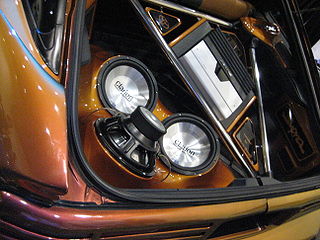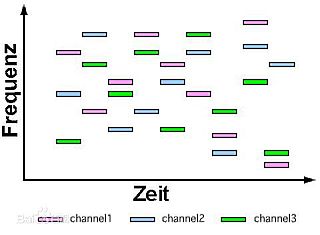The ISM radio bands are portions of the radio spectrum reserved internationally for industrial, scientific and medical (ISM) purposes other than telecommunications. Examples of applications for the use of radio frequency (RF) energy in these bands include radio-frequency process heating, microwave ovens, and medical diathermy machines. The powerful emissions of these devices can create electromagnetic interference and disrupt radio communication using the same frequency, so these devices are limited to certain bands of frequencies. In general, communications equipment operating in these bands must tolerate any interference generated by ISM applications, and users have no regulatory protection from ISM device operation.
Radio frequency (RF) is the oscillation rate of an alternating electric current or voltage or of a magnetic, electric or electromagnetic field or mechanical system in the frequency range from around 20 kHz to around 300 GHz. This is roughly between the upper limit of audio frequencies and the lower limit of infrared frequencies; these are the frequencies at which energy from an oscillating current can radiate off a conductor into space as radio waves. Different sources specify different upper and lower bounds for the frequency range.

In electronics and telecommunications a transmitter or radio transmitter is an electronic device which produces radio waves with an antenna. The transmitter itself generates a radio frequency alternating current, which is applied to the antenna. When excited by this alternating current, the antenna radiates radio waves.
The S band is a designation by the Institute of Electrical and Electronics Engineers (IEEE) for a part of the microwave band of the electromagnetic spectrum covering frequencies from 2 to 4 gigahertz (GHz). Thus it crosses the conventional boundary between the UHF and SHF bands at 3.0 GHz. The S band is used by airport surveillance radar for air traffic control, weather radar, surface ship radar, and some communications satellites, especially those used by NASA to communicate with the Space Shuttle and the International Space Station. The 10 cm radar short-band ranges roughly from 1.55 to 5.2 GHz. The S band also contains the 2.4–2.483 GHz ISM band, widely used for low power unlicensed microwave devices such as cordless phones, wireless headphones (Bluetooth), wireless networking (WiFi), garage door openers, keyless vehicle locks, baby monitors as well as for medical diathermy machines and microwave ovens. India's regional satellite navigation network (IRNSS) broadcasts on 2.483778 to 2.500278 GHz.
Uniden Holdings Corporation is a Japanese company in the wireless communication industry.
Cobham plc is a British manufacturing company based in Wimborne Minster, Dorset, England. It is listed on the London Stock Exchange and is a constituent of the FTSE 250 Index.

Jabra is a global brand specializing in audio & video equipment. It is owned by GN Audio, which is part of GN Group. Jabra engineers, manufactures and markets wireless, true wireless and corded headphones for consumers and enterprises. Jabra Corporation was acquired by GN Audio in 2000.

Clarion Co., Ltd. is a Japanese manufacturer of car audio, automotive navigation systems, AutoPCs, visual equipment, bus equipment, and communication equipment. It is majority owned by Hitachi and joined by Foxconn.

A video sender is a device for transmitting domestic audio and video signals wirelessly from one location to another. It is most commonly used for sending the output of a source device, such as a satellite television decoder, to a television in another part of a property and provides an alternative to cable installations.
Tiger Corporation is a Japanese multinational manufacturer and marketer of vacuum flasks and consumer electronics including electric kettles, hot water dispensers, electric water boilers and rice cookers. It has subsidiaries in China, Taiwan, and the United States.
Biostar Microtech International Corp is a Taiwanese company which designs and manufactures computer hardware products such as motherboards, video cards, expansion cards, thermal grease, headphones, home theater PCs, remote controls, desktops, barebone computers, system-on-chip solutions and industrial PCs.

Radio is the technology of signaling and communicating using radio waves. Radio waves are electromagnetic waves of frequency between 30 hertz (Hz) and 300 gigahertz (GHz). They are generated by an electronic device called a transmitter connected to an antenna which radiates the waves, and received by a radio receiver connected to another antenna. Radio is very widely used in modern technology, in radio communication, radar, radio navigation, remote control, remote sensing and other applications. In radio communication, used in radio and television broadcasting, cell phones, two-way radios, wireless networking and satellite communication among numerous other uses, radio waves are used to carry information across space from a transmitter to a receiver, by modulating the radio signal in the transmitter. In radar, used to locate and track objects like aircraft, ships, spacecraft and missiles, a beam of radio waves emitted by a radar transmitter reflects off the target object, and the reflected waves reveal the object's location. In radio navigation systems such as GPS and VOR, a mobile receiver receives radio signals from navigational radio beacons whose position is known, and by precisely measuring the arrival time of the radio waves the receiver can calculate its position on Earth. In wireless radio remote control devices like drones, garage door openers, and keyless entry systems, radio signals transmitted from a controller device control the actions of a remote device.
LDMOS is a planar double-diffused MOSFET used in amplifiers, including microwave power amplifiers, RF power amplifiers and audio power amplifiers. These transistors are often fabricated on p/p+ silicon epitaxial layers. The fabrication of LDMOS devices mostly involves various ion-implantation and subsequent annealing cycles. As an example, The drift region of this power MOSFET is fabricated using up to three ion implantation sequences in order to achieve the appropriate doping profile needed to withstand high electric fields.
Wireless Home Digital Interface (WHDI) is a consumer electronic specification for a wireless HDTV connectivity throughout the home.
There are several uses of the 2.4 GHz band. Interference may occur between devices operating at 2.4 GHz. This article details the different users of the 2.4 GHz band, how they cause interference to other users and how they are prone to interference from other users.
Gigaset AG, formerly known as Siemens Home and Office Communication Devices is a multinational corporation based in Munich, Germany. The company is most active in the area of communications technology. Gigaset manufactures DECT telephones. In 2017, it had 930 employees, revenue of 293 million Euro and sales activities in approximately 70 countries.
Rohde & Schwarz GmbH & Co KG is an international electronics group specializing in the fields of electronic test equipment, broadcast & media, cybersecurity, radiomonitoring and radiolocation, and radiocommunication. The company provides products for the wireless communications, broadcast & media, cybersecurity and electronics industry, aerospace and defense, homeland security and critical infrastructures. It was founded in 1933.

Wireless security cameras are closed-circuit television (CCTV) cameras that transmit a video and audio signal to a wireless receiver through a radio band. Many wireless security cameras require at least one cable or wire for power; "wireless" refers to the transmission of video/audio. However, some wireless security cameras are battery-powered, making the cameras truly wireless from top to bottom.

Frequency selection and frequency hopping communication technology is a unique spread spectrum communication technology.